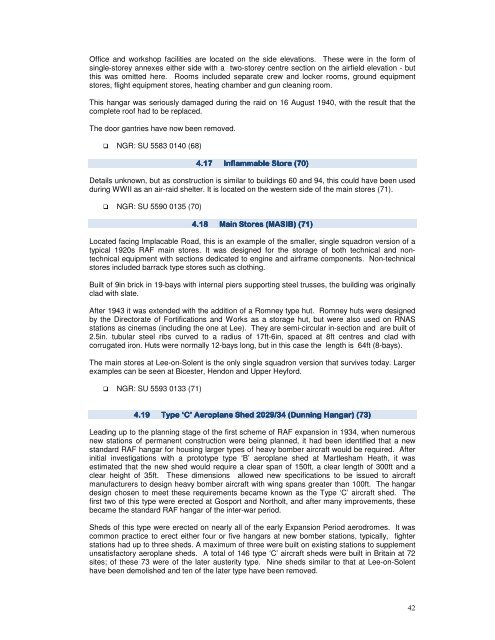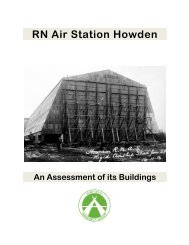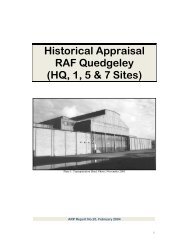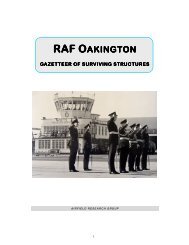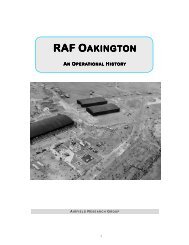RNAS Lee - The Airfield Research Group
RNAS Lee - The Airfield Research Group
RNAS Lee - The Airfield Research Group
Create successful ePaper yourself
Turn your PDF publications into a flip-book with our unique Google optimized e-Paper software.
Office and workshop facilities are located on the side elevations. <strong>The</strong>se were in the form of<br />
single-storey annexes either side with a two-storey centre section on the airfield elevation - but<br />
this was omitted here. Rooms included separate crew and locker rooms, ground equipment<br />
stores, flight equipment stores, heating chamber and gun cleaning room.<br />
This hangar was seriously damaged during the raid on 16 August 1940, with the result that the<br />
complete roof had to be replaced.<br />
<strong>The</strong> door gantries have now been removed.<br />
� NGR: SU 5583 0140 (68)<br />
4. 4.17 4.<br />
Inflammable Inflammable Inflammable Store Store (70)<br />
(70)<br />
Details unknown, but as construction is similar to buildings 60 and 94, this could have been used<br />
during WWII as an air-raid shelter. It is located on the western side of the main stores (71).<br />
� NGR: SU 5590 0135 (70)<br />
4. 4.18 4.<br />
Main Main Stores Stores (MASIB MASIB MASIB) MASIB (71)<br />
Located facing Implacable Road, this is an example of the smaller, single squadron version of a<br />
typical 1920s RAF main stores. It was designed for the storage of both technical and nontechnical<br />
equipment with sections dedicated to engine and airframe components. Non-technical<br />
stores included barrack type stores such as clothing.<br />
Built of 9in brick in 19-bays with internal piers supporting steel trusses, the building was originally<br />
clad with slate.<br />
After 1943 it was extended with the addition of a Romney type hut. Romney huts were designed<br />
by the Directorate of Fortifications and Works as a storage hut, but were also used on <strong>RNAS</strong><br />
stations as cinemas (including the one at <strong>Lee</strong>). <strong>The</strong>y are semi-circular in-section and are built of<br />
2.5in. tubular steel ribs curved to a radius of 17ft-6in, spaced at 8ft centres and clad with<br />
corrugated iron. Huts were normally 12-bays long, but in this case the length is 64ft (8-bays).<br />
<strong>The</strong> main stores at <strong>Lee</strong>-on-Solent is the only single squadron version that survives today. Larger<br />
examples can be seen at Bicester, Hendon and Upper Heyford.<br />
� NGR: SU 5593 0133 (71)<br />
4. 4.19 4.<br />
Type Type Type ‘C’ ‘C’ Aeroplane Aeroplane Shed Shed 2029/34 2029/34 (Dunning (Dunning Hangar) Hangar) (73) (73)<br />
(73)<br />
Leading up to the planning stage of the first scheme of RAF expansion in 1934, when numerous<br />
new stations of permanent construction were being planned, it had been identified that a new<br />
standard RAF hangar for housing larger types of heavy bomber aircraft would be required. After<br />
initial investigations with a prototype type ‘B’ aeroplane shed at Martlesham Heath, it was<br />
estimated that the new shed would require a clear span of 150ft, a clear length of 300ft and a<br />
clear height of 35ft. <strong>The</strong>se dimensions allowed new specifications to be issued to aircraft<br />
manufacturers to design heavy bomber aircraft with wing spans greater than 100ft. <strong>The</strong> hangar<br />
design chosen to meet these requirements became known as the Type ‘C’ aircraft shed. <strong>The</strong><br />
first two of this type were erected at Gosport and Northolt, and after many improvements, these<br />
became the standard RAF hangar of the inter-war period.<br />
Sheds of this type were erected on nearly all of the early Expansion Period aerodromes. It was<br />
common practice to erect either four or five hangars at new bomber stations, typically, fighter<br />
stations had up to three sheds. A maximum of three were built on existing stations to supplement<br />
unsatisfactory aeroplane sheds. A total of 146 type ‘C’ aircraft sheds were built in Britain at 72<br />
sites; of these 73 were of the later austerity type. Nine sheds similar to that at <strong>Lee</strong>-on-Solent<br />
have been demolished and ten of the later type have been removed.<br />
42


